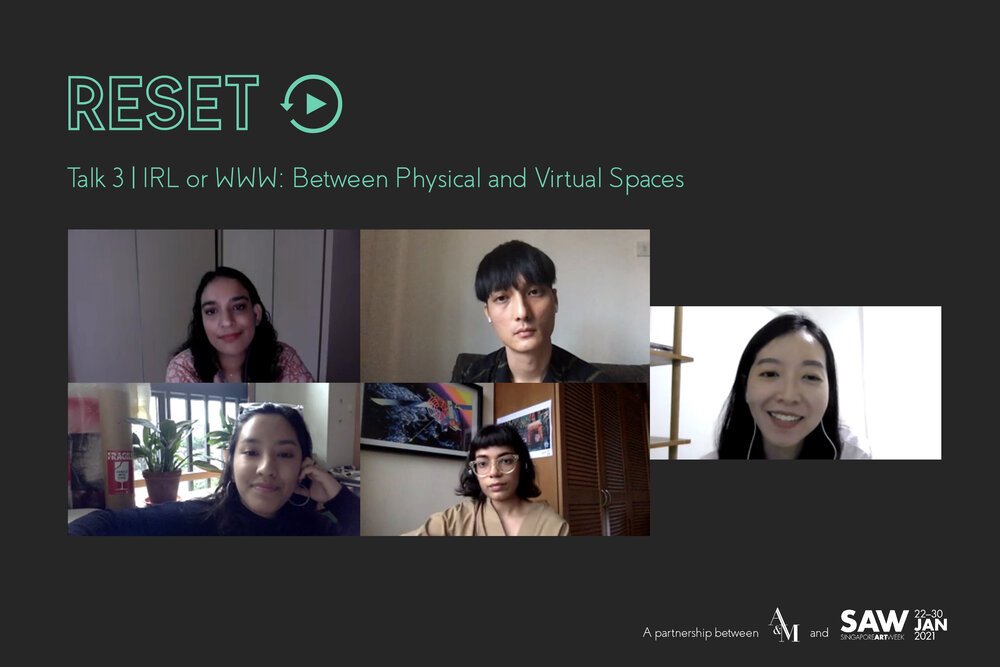RESET Talk 3 | IRL or WWW: Between Physical and Virtual Spaces
Kirti Upadhyaya, Nature Shankar, Teow Yue Han and Tulika Ahuja
By Lara Tan
Key points:
Projects that offer both physical and digital experiences provide multiple entry points instead of explicitly prioritising one format over the other
Digital art and its activations have always been part of the art world and will be increasingly integrated into physical shows even after the pandemic
While it is challenging to archive digital shows, these difficulties also spur conversations about what it means to archive and precipitate innovative ways of doing so
The third talk for RESET, presented by A&M in partnership with Singapore Art Week 2021, saw a reflective discussion on how curators, artists and art spaces have adapted the virtual into their practices, as well as the tensions and alignments that arise from the increased number of digital iterations of artworks and exhibitions. The panel featured Kirti Upadhyaya, Assistant Curator, OH! Open House; Nature Shankar, Co-Founder, Our Softest Hour; Teow Yue Han, artist and Co-Founder, INTER–MISSION and Tulika Ahuja, curator and Founder, MAMA MAGNET. The session was moderated by Selene Yap, Assistant Curator, Singapore Art Museum.
Here are the takeaways from the panel:
Projects that offer both physical and digital experiences provide multiple entry points instead of explicitly prioritising one format over the other. Selene noted that all of the panellists’ projects for Singapore Art Week (SAW) merge the virtual and material realms and posed the question of whether a hierarchy existed between the two. Tulika stated that for Inner Like The OutAR, the experience was designed to create a seamless experience that blur the line between augmented and material reality even though the visitors encounter the physical space first. For Yue Han, the priority is to bring representations of physical spaces into the digital screenings of Deep Field Cinema, intentionally creating a disruptive experience to remind the audience of presentation’s spatiality. Kirti shared that OH! prioritises the physical experience as it is the foundation of the organisation’s practice, but noted that creating a seamless experience between the digital and physical was still important for their upcoming SAW events. Nature said that Our Softest Hour is still playing along the seams of the two realms and that the hierarchy is not necessarily fixed as there are many ways to access their projects.
Digital art and its activations have always been part of the art world and will be increasingly integrated into physical shows even after the pandemic. The panellists agreed that the digital and physical will continue to complement each other even after the pandemic ends. Selene observed that everyone on the panel already had digital elements in their practices before the pandemic, and believes that these will not be tossed aside after the pandemic ends. Tulika pointed out that the collapsing of boundaries between the digital and physical should be purposeful and needs to be able to generate meaning or to otherwise meet the desired outcomes of a project.
While it is challenging to archive digital shows, these difficulties also spur conversations about what it means to archive and precipitate innovative ways of doing so. Yue Han highlighted how the digital realm is more democratic in its archival process as many elements are up on the internet in perpetuity, a point which Selene echoed, and that every individual has the opportunity to keep a small part of the virtual experience. Nature delineated the challenges of preserving the afterlife of works that are site-specific and participatory in nature. She elaborated that the process is less linear and more collaborative as it involves individuals who are traditionally not involved in the process, such as web developers.
Other noteworthy observations include the variable depths of audience engagement in the competitive attention economy, the vulnerabilities of virtual spaces and the need for robust cybersecurity and data protection. These are subjects to consider as the digital becomes more integral in exhibitions and other artistic presentations.
Watch the full recording of RESET Talk 3 | IRL or WWW: Between Physical and Virtual Spaces here:
If you'd like, you can skip to:
2:42 – for Kirti's introduction
6:20 – for Tulika’s introduction
9:35 – for Nature’s introduction
11:23 – for Yue Han’s introduction
15:30 – for panel discussion
If you would prefer to listen to this as a podcast recording, click here:
You can also access the podcast by searching “artandmarket” on Apple Podcasts and Spotify.
RESET, presented by A&M in partnership with Singapore Art Week 2021, runs from December 2020 to January 2021 on Zoom. The talks are free for all to attend with registration. Click here to find the full programme details and to secure your spot for Talk 4 | Back to Basics: Material Practices in the Digital Age.






